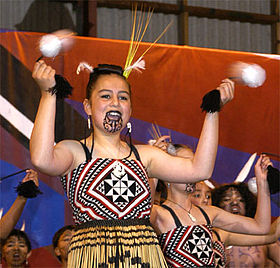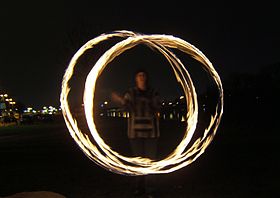Difference between revisions of "AY Honors/Māori Lore/Answer Key"
| Line 3: | Line 3: | ||
| − | |||
| − | |||
| − | |||
| − | |||
| − | |||
| − | |||
| − | |||
| − | |||
| − | |||
| − | |||
| − | |||
| − | |||
| − | |||
| − | |||
| − | |||
| − | |||
| − | |||
| − | |||
| − | |||
| − | |||
| − | |||
| − | |||
| − | |||
== Poi construction == | == Poi construction == | ||
Revision as of 15:47, 22 March 2007
Poi is a form of juggling 'Impartial Art' & (Finnigan, 1992) with balls on ropes, held in the hands and swung in various circular patterns, similar to club-twirling. It was originally practiced by the Māori people of New Zealand (the word poi means "ball" in Māori). Women and men used it to increase flexibility, strength, and coordination. It developed into a traditional performance art practiced mostly by women. This art, in conjunction with others including waiata a ringa, haka and titi torea, make up the performance of kapa haka (Māori culture groups).
Poi construction
Many poi spinners, amateur and professional alike, prefer to create their own poi. A simple pair of practice poi require little more than a pair of socks and a couple of tennis balls. More impressive poi can be made from a multitude of different materials. Kite cords are lightweight and readily available. Chain is a more durable alternative to regular cord. Ball chains can rotate freely so as to prevent tangling, and metal cables can make for extremely fast poi. Long socks can also be used with a weight in one end and a knot in the other. More advanced spinners may add a weight to the handle, in order to improve their ability to perform advanced techniques (such as throws and contact poi).
Kevlar wicks and a variety of poi heads can be bought either from juggling shops or online, and a number of different kinds of hand grip are available too. This way a performer can customise their poi to suit their own personal preference.
Following are a number of arts from different cultures that bear an affinity to poi. Altogether these disciplines (along with more familiar circus skills such as juggling, diablo and devil sticks) are often referred to as Object Manipulation.
- Staff
- Staffers are one of the largest factions in the juggling community. In a similar way to poi spinners, staff spinners use one or two staffs to make a variety of patterns. Staffs, being large blunt objects, are known for being slightly more dangerous than poi when beginning, but many find they prefer staff tricks once experienced. Many similar techniques can be employed to those found in martial arts like bojutsu.
- Glowstringing
- Glowstringing is a similar art to poi, largely developed and advocated by the rave community, before spreading throughout electronic music culture. It involves spinning glowsticks to make patterns in the air at raves or in the club scene. While often mistaken for poi, it is in fact a separate discipline, and the two styles have had some influence on each other. Some people would argue that there is no difference at all between the disciplines as they both use the same tricks and equipment to some extent, only real difference is the scene.
- Club swinging
- Using regular juggling clubs, the head of the club can be held in the palm, and the club swung in poi-like patterns. Many poi moves can be attained this way, and as clubs can be stopped at any point of their swing, or swung as slowly as you like, some poi spinners find them useful in learning more difficult poi moves in 'slow motion'. Club swinging is, however, a completely separate discipline with its own techniques and performers.
- Sword spinning
- Taking influence from the sword displays of the Shaolin monks, some performers learn to do tricks with swords. Swords require a lot more suppleness of the wrists, but can be far faster and more dramatic than poi performances. Practicing with bokken (Japanese wooden practice swords) or simple wooden staves is advisable, but when a performer is skilled enough, fire swords can be bought and constructed.
- Nunchaku
- Nunchaku, as popularized in the media by actor Bruce Lee, employ many similar techniques to poi. While originally a weapon, some companies now produce LED-lit nunchaku which can be used to create unique patterns in performances, though nunchaku remains (and is often regulated as) a weapon.
- Meteor
- A meteor (known to martial artists as a meteor hammer or meteor fist) is long rope, weighted on both ends, often with a monkeyfist knot. It can be used similarly to poi as well as a staff, by keeping very precise timing so that the two balls exert equal centripetal force on each other and move in sync. Originally a Chinese weapon, meteor are extremely difficult to control. Fire meteors and other variations of this tool also exist.
Safety
Depending on their construction, poi can strike the user (or bystanders) with enough force to cause bruising or minor injury. Fire poi can cause burns because the metal parts become very hot and have a very high heat transfer coefficient. The actual wick has a lower coefficient and is less likely to cause burns, but it can spray or spread fuel and the performer's clothing can catch fire. Costumes for fire spinning should be made of non-flammable materials, such as cotton and leather. Synthetic fibers tend to melt when they burn and can cause very severe burns.
Fire poi require a safety regime to deal with the risks of setting on fire either the user, bystanders, or the surroundings. All fire performances should have a sober, rested, and alert spotter who has access to a fire extinguisher (for putting out material and fuel fires), a damp towel (for extinguishing burning clothes and for extinguishing fire toys at the end of a performance), and a bucket of water (in case a clothing fire gets out of control). The fuel dump should be a metal container located far from the performance area that can quickly be sealed so as to be airtight. This will provide a means to extinguish a fire in the fuel dump. A paint can is an ideal example.
Notes
- ↑ The evocative term 'Impartial Art' cleverly associates juggling arts with Martial Arts and in poignant point-counterpoint contrasts the inherently non-violent aspect of jugging disciplines.
References
- Finnigan, Dave (1992). The Zen of Juggling. Human Kinetics Europe Ltd. ISBN-10: 0961552158 & ISBN-13: 978-0961552152
External links
- Maori.org.nz Traditional Māori poi performance
- Home of Poi One of the largest and most influential poi communities in the world.
- Spherculism~ Advancing the moving arts
- Tribe.net's Art of Poi Forum, photo gallery, and event calendar.
- Fire Poi World-wide fire poi trainers & performers.
- PlayPoi Poi website featuring videos and photos, both artistic and instructional
- Do More Poi Poi Lessons, Forums, Funkiness.
- Poi Poi Tuition Resource Downloadable Poi lessons, and an active poi community
- Research in New Zealand Performing Arts - a free online research journal that discusses Maori music and related performing arts.
bg:Пой cs:Poi da:Poi de:Poi fr:Poi he:פוי nl:Poi (jongleren) ja:ポイ (ジャグリング) nn:Poi pl:Poi ru:Пои sk:Poi (žonglovanie) sv:Poi


